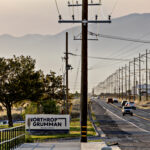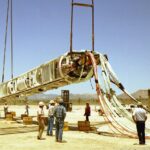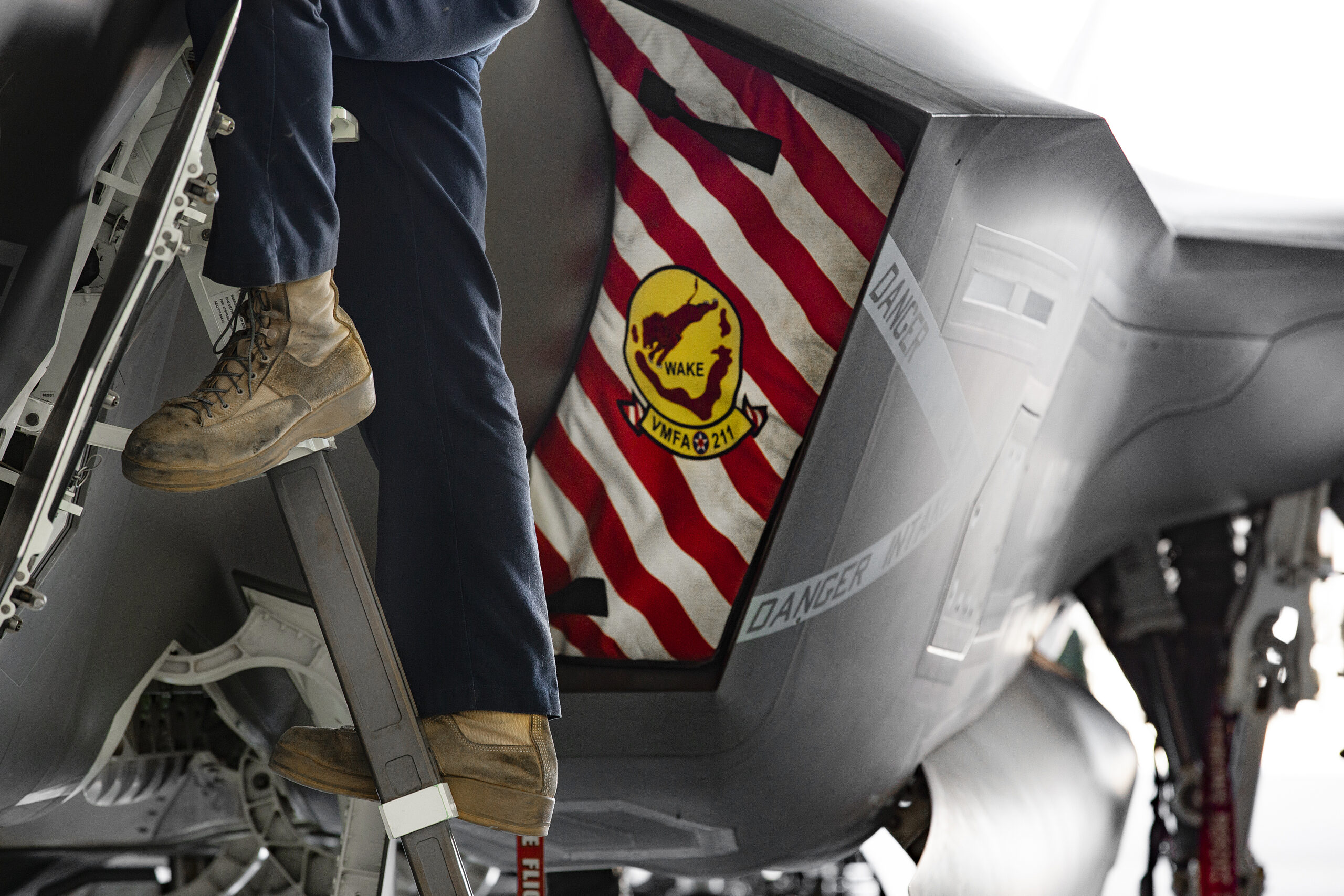Andy Dean, a native of the north Atlanta suburb of Marietta, joined his town’s most storied employer four decades ago. The Lockheed plant there is home to the longest-running military aircraft production line in history, dating back to the early years of the Cold War and the boom in military spending that the conflict ushered in. In the decades since, the plant has rolled off 2,600 C-130 Hercules, the cargo plane used to evacuate people from Kabul as the Taliban retook the country in 2021, and 187 F-22s, a fighter jet recently used to shoot down a Chinese balloon off the coast of South Carolina.
When Dean signed up as a Lockheed firefighter, it was a time when the company handed out turkeys and hams to employees for the holidays and workers’ kids got toys from the company Santa Claus. The health insurance was great, as was the pension (his coworkers hired after 2011 no longer get the latter). In those days, he said, “if you could get a job like this, you were a lifer, pretty much. It was odd for anybody to quit.”
That isn’t to say the work was easy. One time, he rescued an employee who had fallen from a ladder into a substation and had burned off both of his arms crossing a circuit on the way down. Dean would later see the man return to work with prosthetic limbs. Another time, he responded to a C-130 accident that killed seven workers. He stood by as an emergency medical dispatcher documented each death, finishing one corpse and moving on to the next as Dean then sealed his coworkers in body bags.
For a while, Lockheed’s fortunes and the strength of its union, the Machinists Local Lodge 709, grew together. The local bargaining unit’s strength peaked around the 1960s and 70s, when it had about 30,000 members, according to staffers. Union elections took up to three days to complete, as tellers hand counted ballots late into the night. In the meantime, the company grew to occupy a singular space in the $2.2 trillion global military market, as Lockheed became the largest US government contractor and the top weapons seller in the world.
Schroeder recalled then-Lockheed labor negotiator, Dale Kelly, telling him and other union leaders in 2014 that subcontracting any job that doesn’t involve touching the plane was the company’s labor strategy.
Dean was committed to his career there, but the corporation was not committed to him. In 2021, he and his coworkers heard rumors that the defense contractor would let them go and subcontract their firefighting. It came after years of the company steadily chipping away at their bargaining unit by subcontracting jobs like groundskeeping, warehousing, and janitorial. After the firefighters lost their jobs (one who took a position with the subcontractor later told Dean he was making $19 an hour versus $40 when unionized), labor leaders heard that the staff medical technologist was next.
The Marietta union is nowadays down to about 2,000 people, according to the local’s president — and their dwindling collective bargaining strength is part of a broader downward trend at major defense contractors (see chart).
From “Friendlier Times” To Anti-Union Ones
“Everyone’s scared. Everyone’s worried about whether their job is next,” Local 709’s President Jason Schroeder told Inkstick. For every four people they onboard, he said, five leave; Delta Airlines offers competitive wages and snaps up some departees. Schroeder recalled then-Lockheed labor negotiator, Dale Kelly, telling him and other union leaders in 2014 that subcontracting any job that doesn’t involve touching the plane was the company’s labor strategy. He remembered her saying, “we are actively looking for ways to outsource your job.” Lockheed Martin did not respond to multiple requests for comment from Inkstick Media on Kelly’s comment and the dwindling union figures at the company; spokespeople from Raytheon, Northrop Grumman, General Dynamics and Boeing also did not respond to Inkstick.
In the industry more broadly, the numbers are going in the same direction: Among the top five Pentagon contractors, both the number of unionized employees and relative union strength among the total workforce have trended downward, even as the companies have increased their revenue from the ever-growing US national security budget, which is approaching $1 trillion annually.
Inkstick reviewed decades of corporate annual reports, documents that give investors an overview of companies’ business and financial conditions that are available online and through the Mergent Archives. Those reports often include figures on union activity at major defense contractors; at Lockheed, for example, at least 69% of workers were unionized in 1971. Just 19% were in 2022. At Northrop Grumman, only 4% of workers are unionized.
Unionization Rates Decline at Top Defense Contractors
The numbers are connected to other industry trends, such as automation, subcontracting, anti-union campaigns, moves to “right-to-work” states — where laws undermine union strength — and evolving political calculuses about scattering jobs across Congressional districts. They also are impacted by one-off business moves like mergers and acquisitions, which can bring new workplaces into a company’s fold or get employees off their books and cause their workforce numbers to spike upward or downward. For example, Raytheon’s merger with United Technologies in 2020 brought a large contingent of unionized workers in Connecticut to the company and sent the company’s unionization rate upward. (Those Pratt & Whitney employees make engines both for military and civilian aircraft.) Later that same year, however, the company announced it was building a new Pratt & Whitney plant in “right-to-work” North Carolina, a move the Connecticut-based union warned was part of years of efforts to move jobs out of their unionized workplace to weaker labor environments.
David White, the director of strategic resources at the International Association of Machinists and Aerospace Workers (IAM), told Inkstick that the amicable relationship between defense contractors and their unions in the postwar years deteriorated in later decades.
“Late ‘40s, ‘50s, it was a friendlier time for unions to organize and represent workers,” White said, estimating that Machinists’ peak membership was in the 1970s as a result of relationships built during those early years. Anti-labor policies under Reagan, whose administration dealt a famous blow to the labor movement in 1981 by firing striking air traffic controllers from their federal jobs, set the tone for a decline, he said. “When 1980 hits, that number started to decrease in terms of our union and unions in general.”
White’s union is the largest in the defense industry, and he estimates that about 60,000 of their 600,000 members are in the defense sector. Still, while employers like Lockheed are chipping away at their bargaining units, the Machinists are growing in other directions by looking to areas beyond their traditional ones, such as libraries, Apple retail stores, healthcare, nonprofits, clean energy and semiconductor manufacturing.
“We are, like many other unions, going into several other industries and sectors,” White said.
1979: Hiring by the Busload
John Harrity’s career as an hourly worker at Pratt & Whitney in Connecticut and a Machinists labor leader followed the rise and fall of defense industry unions that White described.
After graduating college, Harrity traveled abroad for a few years before returning to the States and taking a job at a care facility for people with intellectual disabilities. The labor movement attracted him, and he applied to work as a vertical turret lathe operator in 1979 at Pratt & Whitney in order to join a unionized shop. (At the time, Pratt & Whitney, nowadays a division of one of the defense industry’s “big five” contractors, Raytheon, made parts for military aircraft like the F-15.)
“They were hiring literally by the busload,” Harrity told Inkstick. He took a shuttle from the company parking lot to the employment office, filled out an application, and got a job offer alongside most everyone else on his bus. “And when we got back, there was another busload of people.”
Still, while employers like Lockheed are chipping away at their bargaining units, the Machinists are growing in other directions by looking to areas beyond their traditional ones, such as libraries, Apple retail stores, healthcare, nonprofits, clean energy and semiconductor manufacturing.
It was like that, he said, right up until layoffs began in the early 1980s, a time he said was “grueling” for the union. He blamed both a slowdown in the national aviation market and the introduction of large-scale international outsourcing for the job losses.
Pratt & Whitney was an open shop, meaning workers weren’t obliged to join the union. Harrity said the company ran “extremely aggressive” campaigns during the annual period when members had the option to drop out, sending letters to each employee’s home suggesting they were wasting their money on dues. While it’s illegal for companies to threaten to close a workplace should employees choose to join a union, Harrity said the company would skirt the law by telling workers that they were free to organize, but that “conditions here and costs here might have an impact on the overall decision of where to do the work.” And: “There are a lot of opportunities in China.”
A sense of militancy grew as the relationship between the company and its workers became more adversarial. One day in 1980, for example, thousands of workers poured out of the plant to vote on a strike authorization, clogging the streets up to the union hall. Harrity said a story existed in local labor lore (though he couldn’t guarantee it actually happened) that the company’s president, Alexander Haig — who would go on to be Reagan’s secretary of state — got stuck in his limousine amid the human traffic jam.
But in the meantime, automation chipped away at the blue-collar workforce that had populated those masses outside the union hall. When Harrity joined the company in 1979, he would spend about one-and-a-half shifts machining discs that go in the center of the engine used in the F-15 and F-16 fighter jets. But within about five years, processes improved so much that workers could make three-and-a-half discs per shift, significantly reducing the need for workers’ labor hours.
Harrity’s experience also reflected another development unfolding across the defense industry at the time: an increasing proportion of white collar workers. At Lockheed Martin, for example, over half of employees nowadays are engineers, scientists, or IT professionals; in 1970, engineers made up just 13% of its workforce, according to the company’s annual reports. While one large white collar union exists at a top defense contractor (the Society of Professional Engineering Employees in Aerospace, or SPEEA, at Boeing), blue-collar unions like the Machinists, the United Auto Workers and United Steelworkers are more prevalent.
A few years after Harrity’s fellow workers (may have) stalled Haig’s limousine, the company made a move that would play out dozens of times across defense contractors in the decades to come. In 1983 it opened a plant in Columbus, a midsize city in “right-to-work” Georgia. Harrity would visit the plant in the 1990s during an unsuccessful bid to unionize it; at that time, he said, he met workers earning about $6 less an hour than their counterparts in the Northeast.
The Connecticut union would later notch legal victories against similar moves when the company attempted to shift work to Texas, Georgia, Singapore and Japan. In one remarkable showdown, a judge issued an injunction in favor of the union, saying the company hadn’t made adequate attempts to keep the work in Connecticut. That forced the company to radio outbound trucks carrying machinery toward Texas to tell them to return to East Hartford.
Following that news, Harrity said, workers leaped from their job stations and streamed into the streets to greet the trucks, chanting, “Union! Union! Union!”
“You Only Buy a Senator Once”
Workers like Harrity and his colleagues got a double punch in the 1980s and 1990s: In addition to the anti-labor moves broadly taking a toll on American unions, the end of the Cold War came with a temporary drop in military spending and a scramble among weapons contractors to consolidate and remain profitable.
That budget dip didn’t last long (military spending began to rise again in 1999), but the sector shed millions of jobs. While an estimated 3.2 million people were employed in the private defense industry in 1985, that number fell to 1.1 million in 2019, according to the National Defense Industrial Association.
Total Workforce and Total Number of Unionized Employees
When those budget cuts hit, Don Nakamoto represented the Machinists union in the historic Lockheed Martin stronghold of Los Angeles County, where the original Loughhead brothers hailed from. The company’s peak LA county employment was during World War II at 98,000 people, Nakamoto estimated. By the end of the Cold War, that number had fallen to between 8,000 to 9,000; when Nakamoto left his position in the 1990s, it was only around 2,000.
The hemorrhaging of jobs put the union in survival mode, Nakamoto told Inkstick in an e-mail.
“When aerospace/defense was losing so many jobs, which has been the case for the past 40 years, it’s very difficult to motivate the workers to unionize,” he wrote. “They are more concerned about just keeping their jobs. Managements were very good [at] delivering a message that rising labor costs, which unions might bring, could lead to job cuts.”
Nakamoto’s colleagues were also facing off against a vexing frenemy: Georgia Senator Sam Nunn, who had taken the helm of the powerful Senate Armed Services Committee. Lockheed transferred much of its manufacturing work from southern California to “right-to-work” Georgia, which Nakamoto said was a disaster for his union. The move made Lockheed happy “because Sam Nunn was happy,” Nakamoto said, though his union colleagues would be in a sticky spot if they tried to complain to their California congressional representatives, since Nunn was an influential fellow Democrat.
It wouldn’t be the last time Lockheed would transfer jobs away from a union shop. In 2019, Lockheed moved its F-16 plant from a unionized shop in Fort Worth (while Texas is a right-to-work state, Fort Worth is a federal enclave, where the state law doesn’t apply) to South Carolina, the state with the lowest unionization rate in the country. Such a move gets Lockheed more than just cheap labor, Arthur Wheaton, a labor expert who researched job losses in the aerospace and defense industry in the 1990s at MIT, told Inkstick. From the perspective of a government contractor — reliant on Congress choosing to buy its wares — it’s better to have two plants in two states than two plants in one.
“You only buy a senator once,” he said.
“Defend Workers’ Jobs… and a Liveable Future”
Given employment trends in the defense industry — as well as other shifting public opinion about what keeps people safe and secure — some former and current defense industry workers have begun discussing public policies that would add jobs in other sectors of the economy.
For Harrity, the Connecticut Machinist who was hired on a busload of job-seekers back in 1979, the new target is jobs that would address the climate crisis.
He gave a stirring speech, recalling the union’s one-time hesitancy to endorse the civil rights movement because its members were mostly white, or its reluctance to condemn secondhand smoke in workplaces because it represented tobacco workers (“now we shake our heads at what took us so long”).
In 2016, Harrity headed to Chicago for the Machinists’ quadrennial national convention to introduce an ambitious resolution: It called for members to commit to prioritizing climate change and advocate for a “just transition” of its workers to livelihoods in the green economy.
He seemed to be swimming against the current; five people had spoken against the resolution before Harrity took the stand as its lone defender. But he gave a stirring speech, recalling the union’s one-time hesitancy to endorse the civil rights movement because its members were mostly white, or its reluctance to condemn secondhand smoke in workplaces because it represented tobacco workers (“now we shake our heads at what took us so long”). In a surprise move, delegates voted 605 to 500 to support the text.
By 2022, Harrity was no longer a dissenter. A bolder version of his resolution he drafted for that year’s meeting in Las Vegas was now backed by the convention’s executive council and resolutions committee. As they gathered, Congress had just finished passing the third of a trio of energy, infrastructure and science laws to deploy more than half a trillion dollars to wean the United States off fossil fuels and usher in a green transition.
“[O]ur Union is especially vulnerable to the consequences of climate change, with large percentages of IAM members working in at risk occupations and industries,” the text read, calling on the International Association of Machinists to “address this crisis by joining with other unions and organizations in the international climate change movement to actively defend workers’ jobs, rights, and lives, as well as secure a livable future for our children and future generations.”
This time around, everyone who took the mic supported the measure, and it passed unanimously.





















